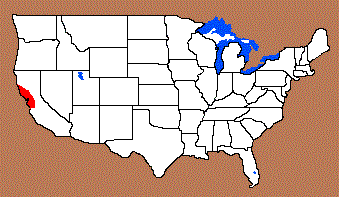Outline is Representative of Size and Shape:

Name Details:
Identified By: Greg White
Named For: Type Site location
Date Identified: 2000
Type Site: Houx Site (Lak-261) Copsey Creek, Lake County, California
Identified By: Greg White
Named For: Type Site location
Date Identified: 2000
Type Site: Houx Site (Lak-261) Copsey Creek, Lake County, California
Point Validity:
Valid type
White is an anthropologist and owner of an archaeology research firm in California. This type was named in a professional publication and has many professional references. This is considered a valid type.
White is an anthropologist and owner of an archaeology research firm in California. This type was named in a professional publication and has many professional references. This is considered a valid type.
Copsey Bi-point
Cluster: Coastal Contracting Stem Cluster Description of Physical Characteristics and Flaking Pattern:
This is a medium ovoid contracting stem point with an elliptical cross section. The blade is excurvate, curving in at the tip and back in at the shoulders edge. Serrations are common on this point. The shoulders are weak to absent with a contracting stem. This point commonly has a leaf appearance with no notable difference where the blade meets the hafting region. The base is convex. This point usually has a random flaking pattern, but chevron or oblique patterns are seen on some examples.
Size Measurements:
Total Length - 41 to 96 mm, Max Blade Width - 21 to 29 mm, Thickness - 7 to 12 mm
Total Length - 41 to 96 mm, Max Blade Width - 21 to 29 mm, Thickness - 7 to 12 mm
Commonly Utilized Material:
Additional Comments:
Copsey Bi-points are considered to be Excelsior type points which have been reworked into drill or engraving tools (Justice, 2002).
Copsey Bi-points are considered to be Excelsior type points which have been reworked into drill or engraving tools (Justice, 2002).
Distribution:

Distribution Comments:
This point is primarily found on the north Coastal Ranges, the San Francisco Bay area, and into the Delta region.
This point is primarily found on the north Coastal Ranges, the San Francisco Bay area, and into the Delta region.
Age / Periods:
Date: 4,000 - 1,500 B.P.
Cultural Period: Late to Transitional Archaic
Glacial Period: Neoglacial to Vandal Minimum
Culture:
Date: 4,000 - 1,500 B.P.
Cultural Period: Late to Transitional Archaic
Glacial Period: Neoglacial to Vandal Minimum
Culture:
Age Details:
Other points in this cluster / Related / Associated Points:
Ano Nuevo, Channel Islands Barbed, Excelsior, Houx Contracting Stem, Point Sal Barbed, Vandenberg Contracting Stem
Ano Nuevo, Channel Islands Barbed, Excelsior, Houx Contracting Stem, Point Sal Barbed, Vandenberg Contracting Stem
